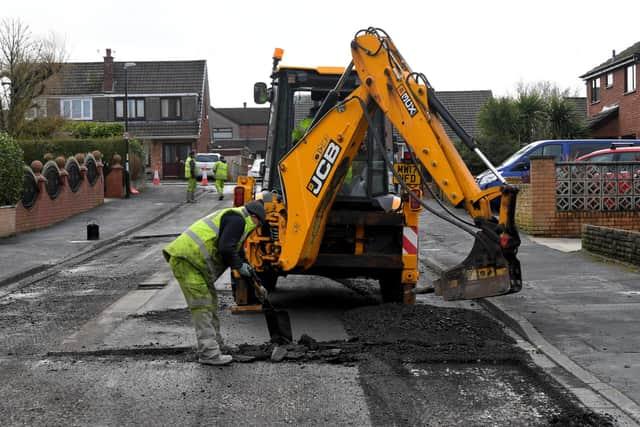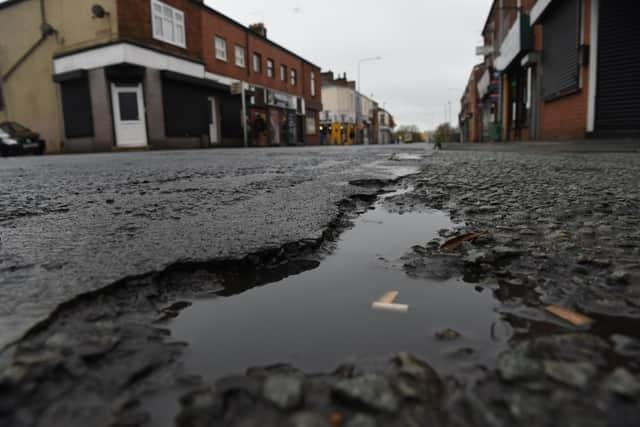Lancashire on course for 100,000 potholes by next year amid 'unprecedented' rise
and live on Freeview channel 276
The call was made during a meeting of Lancashire County Council’s environment, economic growth and transport scrutiny committee, which heard that - at the current rate of increase - there will be almost 105,000 reported road defects in the authority's patch by next year. In 2019/20, the tally - for an area which excludes Blackpool and Blackburn with Darwen - was just under 50,000.
There are currently 11,000 repair jobs in County Hall’s “work in progress” pile. That is a near trebling of the 4,000 figure that was considered the upper limit on capacity as recently as five years ago.
Advertisement
Hide AdAdvertisement
Hide AdA report presented to the committee stated that particularly wet weather starting last summer has "significantly contributed" to the problem, with the network having been "saturated" for a period of more than six months.


Highways group manager Kirstie Williams told the committee that the county council was now dealing with an “unprecedented” number of potholes - with records being broken in both January and February this year. She said that the increase in demand meant that a highways inspector in one of the most under-pressure parts of the county for potholes - Fylde and Wyre - could be expected to carry out up to 70 site visits a day.
It was against that backdrop that county councillors said it was time to give them more direct involvement - so that they could reflect the public’s priorities.
Under the current system, the so-called “reactive” repair of potholes as they appear throughout the year is carried out once a defect has reached a depth of at least 40mm. The potholes are then prioritised for attention depending on their urgency - with repair targets ranging from just four hours for the most serious up to 20 days for non-urgent problems.
Advertisement
Hide AdAdvertisement
Hide AdHowever, the annual pre-planned resurfacing programme - designed to keep Lancashire’s roads in an overall good state of repair - is based on a 15-year strategy known as the Transport Asset Management Plan (TAMP), which prioritises different classifications of road over that period and identifies individual routes in need of work via a video mapping process.


Committee chair Rob Bailey told the assembled throng of highways bosses that councillors wanted to be able to initiate repairs in areas that were “crying out” for action.
“[They’re the] bits that the residents see on a regular basis. They may not be the worst bits as it comes up on a [video] scan, but they are the visible bits…which are in a poor condition.
“We look stupid, as elected members, asking for roads to be [repaired] - and we can’t get anything done,” County Cllr Bailey said.
Advertisement
Hide AdAdvertisement
Hide AdHIs call was echoed across the committee, with St. Anne's South representative Steve Rigby adding that there needed to be “true” input from county councillors.
Head of service for highways John Davies said that the responsive nature of individual pothole repair work made it “very difficult” for county councillors to be involved at that level, but stressed that the department did “engage with members as much as we possibly can” over broader issues.
However, he warned that around £3m a year of the authority’s highway maintenance funding grant from the government depended on the county council adhering to Department For Transport guidance about how to determine which roads were in need of repair - and suggested councillor involvement could jeopardise that.
The report to the committee also noted that if the authority deviated from a "risk-based approach" to repairs, as best practice demands, it could "severely weaken the ability of the council to defend claims and could open [it up] to increased costs and reputational damage".
Advertisement
Hide AdAdvertisement
Hide AdThe latest figures also show that the TAMP strategy has been having the desired effect on the region's roads since it was introduced a decade ago, with the proportion of routes rated red and amber for poor condition decreasing across each main category between March 2014 and March 2023 - from 31 percent down to 19 percent of A-roads, from 48 percent to 25 percent of B-roads and from 55 percent to 32 percent of C-classified routes.
The committee heard that a discretionary pot of road repair funding does exist within the county council’s annual budget, which is used to cover the cost of schemes suggested by county councillors themselves. However, the Local Deterioration Fund (LDF), as it is known, is also drawn upon to deal with issues that develop during the course of the year and is, in any case, almost ten times oversubscribed.
There is currently an estimated £40m of work earmarked for LDF cash, but this year the fund was allocated just £4.6m - albeit an increase on last year - from County Hall’s £32m capital highways budget for mostly pre-planned maintenance work.
An additional £8m for reactive pothole repairs - bolstered by £2m from the capital budget - was enough to do only “small, localised repairs”, rather than patching across a wider area, Kirstie Williams explained. That was in response to a call from Lancaster Central member Gina Dowding for a “smarter” way of working which would allow a road to be assessed "more broadly" when a pothole was being filled in, rather than contractors simply "doing what's in front of them".
Advertisement
Hide AdAdvertisement
Hide AdThe committee resolved to ask the highways department for clarification about the working of the LDF, “with a view to enhanced member engagement in that process”. It also sought a review of the inspection process undertaken in response to the reporting of individual potholes to assess whether they were suitable for repair.
HOW DOES THE COUNTY COUNCIL DECIDE IF A ROAD GETS RESURFACED?
Beyond the allocation of funding for different classifications of road, as dictated by the TAMP, the committee was told that pre-planned repairs were prioritised based on a combination of a road's condition and an assessment of its strategic importance.
Rebecca Makinson, Lancashire County Council's highway asset principal, explained that a "higher weighting" was given to roads deemed so significant that the authority considers them a priority for gritting in winter, as well as bus routes and those that lead to schools and businesses. The number of potholes and public complaints about the route is also factored in. The strategic importance of a road is not a consideration for councillor-suggested schemes funded via the LDF.
The TAMP has been prioritising unclassified urban roads in recent years like those on residential estates - having initially focused on the so-called "ABC routes". Ms. Makinson said the authority was often asked "why a side road is being prioritised over a main road".
Advertisement
Hide AdAdvertisement
Hide AdCllr Bailey said he has sometimes wondered of those roads earmarked for resurfacing, "Why the hell are we doing this? They're minor roads with one house...in the middle of nowhere.
"Visually, they don't need doing, [although] there might be something more fundamentally wrong with them," he acknowledged.
‘POTHOLES AREN’T THE ONLY PROBLEM’
Of the £32m capital highways maintenance pot for 2024/25, £15.2m has been reserved for resurfacing schemes, with the remainder earmarked for the likes of bridge repairs - £5.6m - and work on steetlighting, for which £2.65m has been set aside.
Highways asset manager Paul Binks told the committee that this was vital infrastructure which people did not necessarily “see” in the way as they would notice problems with the road surface, but which was equally in need of maintenance. He said that it was only by the inspections carried out on lampposts that it was noticed “50 percent of the base” of one streetlight column was “missing”.